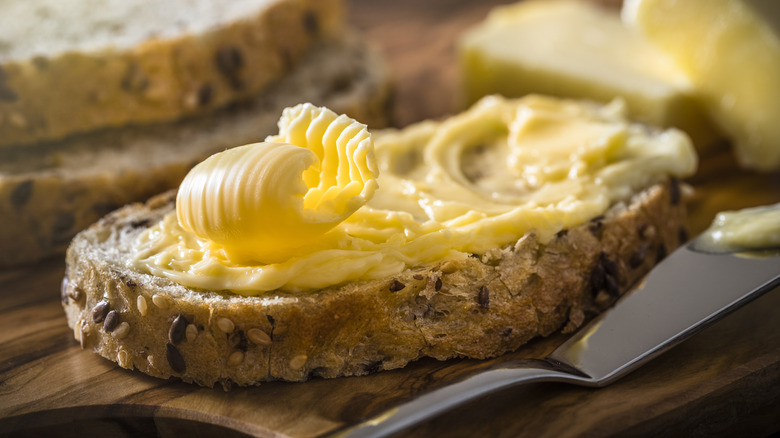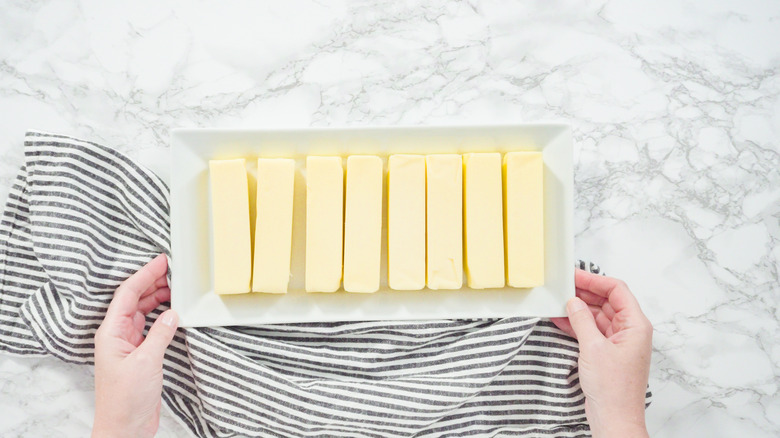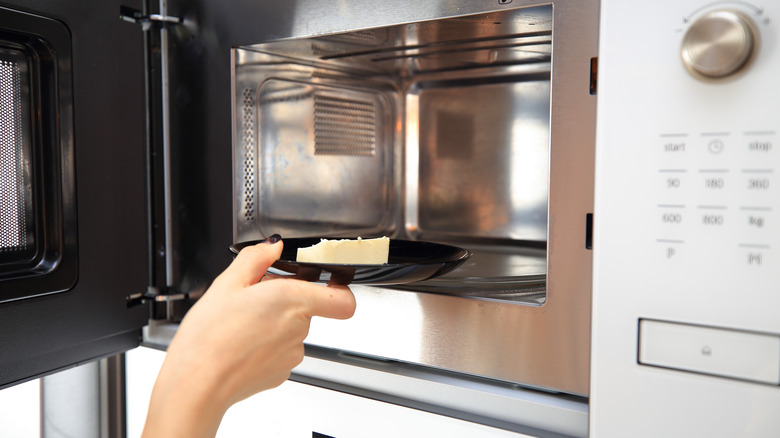Soften Butter Smarter With Your Oven's Residual Heat
Realizing you suddenly need a stick of softened butter for a recipe is among the most annoying scenarios people have in the kitchen. Maybe you've decided to bake a big batch of homemade cookies for the bake sale tomorrow, or, perhaps, a batch of cake frosting turned out disastrously and you need to whip up more. Whatever the case may be, softening butter in a pinch can be intimidating, which is why many plan way ahead, often leaving butter out at room temperature the night before they need it.
Sure, cutting a stick of butter into smaller pieces and leaving it on the countertop will speed up the process (but plenty of time is still necessary), and there is always the trusty microwave (in which butter will go from soft to melted in the blink of an eye), but consider the oven the next time. Obviously, you don't want to pop your cold butter in a 350-degree oven, and it's vital that, if you try this method, you don't really want the oven actively on at all. What you want is low and slow residual heat. Ideally, you've already had something baking in the oven, whether that be a cake, a chicken, a casserole, or a baguette. After the oven is turned off, the oven is still warm and gradually cools down. It's this residual heat that will soften up your butter in no time.
As the oven cools down, it will warm your butter up
To successfully soften your butter in the oven, you'll want the temperature to be about 100 degrees Fahrenheit, so it's a good idea to have an oven thermometer on hand. Remember, you don't want the oven actively on; it's the residual heat you want to work with, or you'll find yourself with a melted butter mess. Place your cold, hard butter on a sheet pan or oven-safe dish and let it warm up for about 10 to 15 minutes. At this point, the butter should be nice and softened, but since every oven is different, keep a close eye on the status of the butter, especially if you're trying this hack for the first time.
If your oven has a "proofing" setting, this is usually the perfect temperature for a task like this. If not, heat the oven on low for a few minutes. This should bring the temperature up to about 100 degrees. Again, an oven thermometer is a wise investment to save you from guessing. To test the softness, you can lightly push down in the middle of the stick of butter. If it feels like the butter could easily be spread on some soft bread, it's ready. You could also push down on the butter with the long side of a toothpick. If it goes through with little resistance, the butter should be perfect.
Other ways to quickly soften butter
As mentioned earlier, microwaving will certainly soften up your butter in record time, but you've got to be super careful and attentive with this method. Typically, you want to heat on a low setting (power level 30%) for only around 30 seconds. If you detect any meltage during this time, take the butter out right away, as it's gotten too warm. Another idea is to make your butter thinner so the chill comes out of the mass quicker. Take a rolling pin or large can and pound your sticks of butter so they become flat. They should be soft in as little as five minutes. Obviously, go this route if you're using the butter for baking and not if you're putting it on the table as an accompaniment to bread.
Another method that's gotten a lot of attention is the warm glass method. To do this, pour hot water into a glass, bowl (or any vessel that will fit over your butter sticks). Wait a few minutes, pour the water out, and immediately cover the butter with the now-warm glass. The word is that this will soften up butter in a matter of minutes. With so many methods to try, softening cold butter in a hurry doesn't have to be intimidating, but rather, an opportunity to master a new method.



